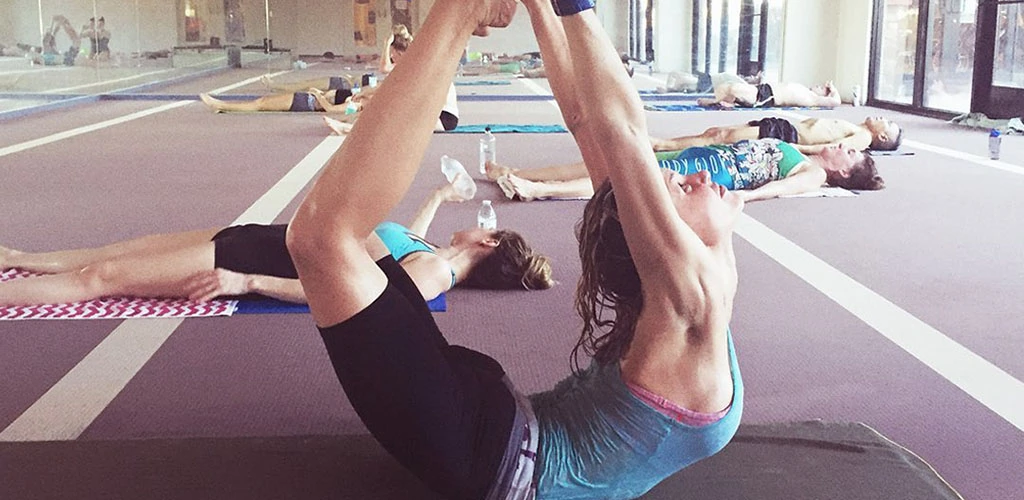Las Vegas, often called Sin City, is a hub for nightlife and entertainment, and many visitors and residents are looking to make memorable connections. I'm here to share my extensive experience with dating in Las Vegas and provide insider insights on the best spots for hookups. Against all advice about living in Las Vegas, I did live there for a while. I worked in one of the corporate offices, and spent countless weekends looking for Las Vegas hookups as a single twenty-something guy who could afford to party every once in a while.
A lot has changed in Vegas over the past few years and you need to be smarter than ever if you want to hookup. Socially distancing isn't as big as it was but it's changed where singles hang out and how to meet them. In fact, This whole social distancing thing has made dating apps more popular. Here are our favorites:
Site Our Experience Our Rating Free Trial Link 
Experience Highlights Try AFF For Free 
Experience Highlights Try eHarmony 
Experience Highlights Try Passion
It doesn’t matter if you’re in Sheep Mountain or down in Meadows Village, everyone’s looking to get laid in Las Vegas. With a city of more than 650,000 residents and a constant stream of tourists and convention attendees (10 million/year), it shouldn’t be hard (you’re not stuck out in Crystal Village, after all).
And yet, let’s face it, we’ve all hit a dry spell at some point.
That’s why we took it upon ourselves to compile this list of the best hookup options. This list, created with the help of locals, will make it so you can get back to playing nightly games of poker, instead of solitaire. Don’t let the coeds at UNLV have all the fun.
Keep reading our list, and once you’ve tried a few of these hookup tools:
Table of Contents
Our favorite spots to find Las Vegas hookups
Whether you’ve lived in Sin City all your life or you’re just visiting, it can be nice to have a little help finding a hookup. These are the best options to find hook ups in Las Vegas.
Methodology: How We Recommend the Best Places in Las Vegas for Hookups
To bring our readers a comprehensive list of the best places for hookups in Sin City, every BeyondAges writer follows strict and verifiable guidelines. Unlike other dating sites, our reviews are always up-to-date and sourced by local experts–not rehashes of stuff you can find elsewhere.
| Methodology | Description |
| Rigorous Testing | Conducting thorough reviews of dating apps and websites through extensive use over weeks/months. |
| Anecdotal Experience | Utilizing the practical experiences of a large team of dating and relationship coaches. |
| Expertise | Leveraging decades of practice in previous and current dating scenes to provide up-to-date and impactful advice. We balance subjectivity in an objective framework to give our readers a more wholistic frame of reference for modern dating. |
| Continuous Learning | Exploring new approaches to dating success to ensure advice remains relevant and effective. This includes out-of-the-box thinking to discover new trends and hacks. |
| Online Focus | We place a significant focus on how online dating and virtual communication affect modern dating dynamics. From apps, sites, chat rooms, video calls - we delve deep into the pros and cons. |
| User Engagement | Engaging with readers to comment and share their experiences to build a vibrant community, enhance trust, and ultimately createa better dating experience. |
AFF is the best option for getting laid in Las Vegas
It doesn't matter if you're a local or just here for the weekend, the easiest way we've seen guys find hookups without a ton of back and forth has been AFF. There are a lot of options that claim to be helpful for this and most of them are a waste of time, especially for guys. AFF is different.
What makes it so good is mostly about the numbers. It has over 60 million active members, a lot of them in Vegas. When you have so many local users, as well as people coming and going, you're going to have a lot of options.
It's also the biggest platform out there that is 100% about hooking up. Tinder is more about relationships these days and nothing else has nearly as many members. When all the women on here are just looking to head to the bedroom it makes it MUCH easier for guys.
If you haven't tried it already check out their free trial below. It actually works for regular guys, especially compared to Tinder! Check it out.
User Testimonials for AFF:
Sachin Dawhan - Quora
But in my experience it’s really not that hard because most male users seem to have problems just being themselves. And this is number one thing females are looking for before they want to know if you are compatible sexually.
They want someone who they can trust.
So I’d emphasize that it’s really not that hard if you are willing to put in the effort. If not, I wouldn’t bother with the site unless you can waste money trying your luck.
Notunek - Reddit
I've only been on AFF for 3 weeks now, but have had a lot of activity. Of course it is easier for females than males to get lots of messages and offers. You have to be thick-skinned because many of the males are very explicit in what they want. It bothered me at first and was a turn-off. I don't mind frank talk about sex, but it's rude in my mind not to introduce yourself, give some details and get to "know" each other a little before you ask if she likes DBA...
Atomic Vegas is an explosive good time if you want to get laid in Las Vegas

@AtomicLasVegas
Most locals avoid the Strip like the plague, which is how they end up at Atomic, the oldest freestanding bar and solid spot for Las Vegas hook ups. Known for its impressive beer list and cool, divey vibe, this bar is located close enough to the desert, people once watched nuclear tests from its roof. Luckily, you don’t have to get irradiated to have a blast at Atomic these days.
In addition to its varied list of beers on draft, the owners recently opened up The Kitchen at Atomic for some great eats. It makes the location the perfect one-stop shop for your night out. Grab a bite, drink some beers and get cozy with a sexy stranger. In terms of hookup bars, Atomic blows the competition away.
This iconic bar is a local favorite, known for its impressive beer list and laid-back vibe. It's the perfect spot to grab a drink, enjoy great food, and strike up conversations with fellow patrons.
The one thing I've learned about Atomic is that it attracts lots of people who come to the city for conventions. Some of them are bored out of their minds and just want a few drinks to take the edge off. Now don't let this put you off because those bored convention-goers are exactly who you want to approach. I once met this beautiful woman from Ohio who just wanted to keep her mind off her job for a few hours, and I was perfectly glad to oblige!
User Testimonials for Atomic Liquors:
Seth Gehman - Google
Loved this dark hole in the wall bar on Fremont Street just blocks from all the glitz and glam. Dark and cozy, you only wish the walls and barstools could tell the stories of the decades it's been open. Supposedly Hunter S. Thompson was a regular there at one time.
If you don’t want to go through all the trouble of snooping through their socials or asking them more detailed questions, there’s a tool you can use to know for sure that the person you’re talking to is who they say they are. It’s Instant Checkmate, a background-checking tool that can help you know more about people you find online–the legal and hassle-free way. All you need are a few of their details and Instant Checkmate will give you all the information you need to verify who you’re really talking to online.
Try out Instant Checkmate’s free trial and see just how easy it is to get all the info you need. Better safe than sorry!
This iconic bar is a local favorite, known for its impressive beer list and laid-back vibe. It's the perfect spot to grab a drink, enjoy great food, and strike up conversations with fellow patrons.
The one thing I've learned about Atomic is that it attracts lots of people who come to the city for conventions. Some of them are bored out of their minds and just want a few drinks to take the edge off. Now don't let this put you off because those bored convention-goers are exactly who you want to approach. I once met this beautiful woman from Ohio who just wanted to keep her mind off her job for a few hours, and I was perfectly glad to oblige!
The best Las Vegas pickup bars we've tried
If you’re a drinker or just someone who enjoys going out at night, you need to find the right bars. Below are some of our favorite bars. Not only because they’re cool, but because they’re among the best places to pick up girls in the city.
Velveteen Rabbit is the ideal bar to find hook ups in Las Vegas

@velveteenrabbitlv
This might be controversial, but we’ll stand by it: “What happens in Vegas, stays in Vegas” was a terrible slogan. It succeeded as an ad campaign, sure, but thanks to it and the “Hangover” movies, Vegas’ cool sophistication was lost. When people think about our city, they thank wild drinking and blackout drunks. Yes, we have our share of both, but Vegas was once a city of class and style.
That’s what Velveteen Rabbit takes you back to every time you walk in. It’s a dimly lit, unpretentious example of how to do a cocktail lounge right, with just a touch of sensuality. There are a dozen reasons to love this bar, including their signature cocktails and impressive spirits list. And then there’s the fact that it’s a popular hangout for girls who can hold their own. That includes Henderson girls looking for a good time.
They also do special events like cocktail classes if you’re looking for a fun group activity. The cocktail class is a novel idea for a first date. Invite that girl you’re keen on along with your friends for an inebriated outing with a twist. Perfect for showing off your fun side in a relaxed environment. However you experience Velveteen Rabbit, we’re confident it’ll make you appreciate the city even more.
So escape the stereotypical Vegas scene and step into Velveteen Rabbit. Bachelorette parties happen here all the time in my experience. And when bridesmaids want to go wild, they really go all in!
User Testimonials for Velveteen Rabbit:
Best businesses with James - Google
This is the place to go in the Arts district for craft cocktails! Velveteen Rabbit is legendary for having the most outlandish cocktails in Vegas. And last night was no exception. My partner and I came on a Tuesday night, so we were seated immediately. On the weekends, you may not be able to get a table at all because of how busy it can get. I got a cocktail called the Cracker Jacker, and my partner got the Blue Ribbon Shortcake. Both drinks were excellent! Mine tasted like actual butter popcorn, I was shocked. I highly recommend this place for anyone looking for a great time in the Arts district.
Don’t Tell Mama ensures you and a guest leave smiling

@donttellmamalv
What is a night out in Las Vegas without a show? No, we’re not talking about Cher or Criss Angel. We mean the kind of entertainment that’s lighthearted but engaging, impressive to watch but seemingly effortless. The classic piano bar always provides a memorable night out without breaking the bank account. And if you’re going to visit a piano bar, go with the best: Don’t Tell Mama.
Located Downtown, Don’t Tell Mama is like Velveteen Rabbit in that it harks back to a less-corporate Las Vegas. However, unlike our favorite local cocktail lounge, this spot isn’t about quiet, intimate chats in dark corners. Instead, a night at Don’t Tell Mama will involve sing-alongs and becoming best friends with total strangers. It’s all but guaranteed. So if you can't find Aurora hookups, then you'll find them here.
The pianists here are consummate entertainers. They are able to play pretty much any song you can think of (and many more you can’t). A nice touch here is they have open mics for patrons to jump up and show off their singing talent. In our experience, few things draw out the single girls like a karaoke night. If you’ve got good pipes, you’ll be an instant star. If you don’t, that’s okay; pretty ladies can always use a handsome stranger offering a drink.
If you're looking for entertainment and a chance to sing your heart out, Don't Tell Mama is the place to be. Join sing-alongs and enjoy the company of enthusiastic patrons for a memorable night. I'm not a singer by any stretch of the imagination, but all it really takes in confidence. I once hooked up with this woman who could sing like Adele, but she didn't mind my terrible singing voice because she thought I was charming. So yes, I can say that karaoke can work in your favor!
User Testimonials for Don't Tell Mama:
Denis Crowder - Google
So much fun. I mean really a karaoke piano bar where all the staff also sing. Good quick service and friendly people and staff. And gotta say best Lemon Drop shot ever!
Food: 5
Service: 5
Atmosphere: 5
Rosina is swanky, cool and full of people looking for Las Vegas hookups

@RosinaBar
If you’re in Vegas, chances are you came for the casinos. If that’s the case, you’ll love how one of the best hook up bars in Vegas is located on the Palazzo’s casino floor. Whether you’ve got a room in the hotel or you’re just trying your hand at the slots, stop into the gorgeous and sexy Rosina cocktail bar. So if hookups in Colorado Springs feel elusive, you'll find them here.
Known for its variety of Manhattan-style drinks and a décor that feels like you’ve fallen through time, this is a sexy bar. Sure, you’ll throw down a few bucks here, but it’s worth it. Bring a date here, or just get to know one of the guests in the hotel. Whatever your way of operating, you should have no problem picking up a one-night stand here.
User Testimonials for Rosina Cocktail Lounge:
Avi Sarfaraz - Google
Excellent cocktail bar with an excellent atmosphere. Good selection of drinks and cocktails with skilled bar staff. Reasonable prices considering it's the strip.
They make a good old fashioned.
Food: 5
Service: 5
Atmosphere: 5
Frankie’s Tiki Room is the best bar to get laid

@FrankiesTiki
Open 24 hours a day, Frankie’s Tiki Room on Charleston Blvd is so committed to the tiki aesthetic. It soars past kitsch and comes right back around to being amazing. This is a bar where everyone is having a good time. The moment you enter, it’s easy to see why. Plus, if the music doesn’t make you smile, we’re afraid for your soul. This combination makes it such a good option for people who are looking for casual hookups near where they live and work.
Open 24/7, this tiki bar offers a unique, fun experience. It's a place where everyone is having a good time, making it an excellent choice for casual encounters. I have this group of friends who enjoy day drinking, and they'd go here pretty often. I've seen firsthand how even day drinking can make finding hookups in Las Vegas so much easier!
User Testimonials for Frankie's Tiki Room:
James Mikkelson - Google
Great atmosphere here. Off the strip, so it's a good place to get away from the usual crowd. Video poker machines in the bar if you still want to gamble.
Great bar service and cool decor. Make the effort to jump in a taxi and come here, you won't be disappointed, especially if you need a change of scene from the strip.
Smoking is fine here, quite a small badly ventilated place, so keep that in mind if you're sensitive.
Price per person: $30–50
Service: 5
Atmosphere: 5
Recommended dishes: Surf Dragon, Wild Watusi
Born and Raised is a great place to score hookups

@bornandraisedlv
Sports bars don’t always make for the best hookup bars. But most sports bars aren’t as cool as Born and Raised. What makes this bar stand out from others is its personality and unique character. Sure, there are TVs on all over the place. But the décor is an eclectic mix of styles that creates an undeniably welcoming and comfortable atmosphere. This has also been a pretty decent spot for picking up BBW in Vegas. In our experience, these women are more likely to be sports fans and love this place.
As the official bar of the Golden Knights, this bar wears its city pride on its sleeve, and that’s a big part of its charm. Locals come out for the games and camaraderie, while visitors drop in for the excellent food and drinks. Whatever brings you out to Born and Raised, you’re sure to make a new friend or two, even if it’s just for one night.
User Testimonials for Born and Raised Las Vegas:
Sean D - Google
Second review but a different location. This BAR location is just as good as the first!! The staff was super friendly and the food was amazing! We had the pulled pork sliders and burger sliders along with the loaded tater tots! Devore is different at each location and their private room is beautiful (not pictured) and this location also has an outdoor patio for relaxed dining! A definite must try!
Price per person: $10–20
Food: 5
Service: 5
Atmosphere: 5
ReBAR reflects Vegas’ odd personality

@rebarlv
For our final bar recommendation, we’re including ReBAR on Main Street. This is easily one of best bars to get laid and find single women seeking men. Not least of which because it’s full of cool people and antiques available to buy. In fact, their motto is “Everything’s For Sale.” That means you can drink, eat a vegan hot dog and buy some weird doohickeys (proceeds go to charity).
We feel compelled to include ReBAR on our list of bars in the city. That's because this place draws a cool, up-for-anything type crowd. When you’re in here, you truly feel like the night could go anywhere. That's a pretty nice summary of Vegas itself. Give this bar a shot, and at the very least, you’ll be supporting a good cause with every purchase.
User Testimonials for ReBAR:
Sean D - Google
Great beer prices. Pitchers and cool stuff to buy or look at. Worth the trip. On a Friday night lots of energy. College or old American bar feel.
Service: 5
Atmosphere: 5
Honorable Mention Bars
You can never have too many good bars in your life. Here are a few more you should frequent:
Drinking Responsibly in Las Vegas
We all love to drink, but drinking responsibly is the key to finding successful hookups in Las Vegas. Dr. Alex Lee, a renowned expert in the field of addiction, mental health, and trauma, offers some tips to keep in mind. Dr. Lee shares some best practices with responsible drinkers like you before you imbibe:
- Choose the right drink: “If hard liquors are your weakness, considering alternatives like beer or wine might be beneficial.”
- Stay hydrated: "A strategy of alternating between alcoholic and non-alcoholic drinks, preferably water, aids in maintaining a steady drinking pace."
- Never drink on an empty stomach: Food has positive effect on curbing the effects of alcohol and hangovers. According to Lee, "Consuming food, particularly if unsure about its availability, before commencing drinking is advisable.”
- Be accountable for your actions: "Social environments, especially with friends, can sometimes make moderation challenging." Lee offers a novel solution: “Bring a trusted friend with you, ideally someone who also wants to drink responsibly. At the start of the night, tell the friend that you’re sticking to X amount of drinks, and you’d like to be held accountable.”
- Evade peer pressure: Being equipped with polite refusal phrases can be handy against peer pressure or discomfort. Some easy-to-remember suggestions from Lee include:
"No thanks, I’m pacing myself."
"I’m still working on this one."
"Taking it easy tonight, I’ve got an early start tomorrow."
Learn more about success in your local bar scene with these BeyondAges articles:
How To Approach A Girl At A Bar And Spark Her Interest
Author: Andrius Saulis
Tip: As a professional dating coach and educator, Saulis talks about the best location for increasing your odds of finding a girl. He says, “An indirect way to approach women in bars … First, find a high-traffic area that many people go through.
Ideally, it should be somewhere near the bar or near the entrance. Sometimes, even a place near the restrooms is a great option. It doesn’t matter where it is, as long as there are many people there doing nothing in particular and women often walking by.
How To Talk To Girls At Bars And Get Them Interested In You
Author: Jennifer Greene
Tip: Greene emphasizes the importance of staying focused on why you went to a bar in the first place: “One of the reasons we love meeting girls in bars is the setting it so casual. If you think this is always the case, though, you’re missing the bigger picture. Yes, after a couple of cocktails, women are more willing to talk to you, but they’re still looking for the same thing they’re looking for any other time. Namely, they want a good catch.”
The hookup apps in Las Vegas dating coaches prefer
A huge number of hookups start online now. You don't have spend all day on the apps but spending 10-20 minutes a week sending messages can really pay off. These are the best hookup apps in the city right now:
| Site | Our Experience | Our Rating | Free Trial Link |
|---|---|---|---|
Best Hookup Site For MILFs  | Experience Highlights
| 9 | Try AFF For Free |
Best For Relationships  | Experience Highlights
| 9 | Try eHarmony |
2nd Best For Hookups  | Experience Highlights
| 8 | Try Passion |
BeyondAges has plenty of in-depth guides for mastering online dating apps:
- The 9 Best Dating Apps in 2024 With Proven Results
- 2024's Best Hookup Apps & Sites We've Tried Personally
- The Best Dating Apps for Nerds We've Tried
The best clubs for finding hookups in Las Vegas
We like to party here in Vegas. I don’t think anyone can dispute that. If there’s one thing that locals and tourists alike love about this city, it’s our club scene. When you’re looking to mingle with all the hot girls to find Las Vegas hookups, you best get on your club clothes. But first, keep in mind a few tips from Wanderlust with Lisa before you head out to Vegas' many clubs:
- Plan ahead: Check DJ lineups about 2 months prior to your trip. Websites like EDM Calendar on electronic.vegas can help you schedule which DJs to see.
- Ladies get in for free: Women often don't need to pay for entry. Get on a promoter's list, which can be found via club Instagram accounts or promoters on the Strip.
- Dress codes matter: Dress codes can be strict, especially for men. Avoid jeans, flip flops, hats, and similar casual wear.
- Keep your itinerary chill: While possible, club hopping is difficult due to the size of hotels and long lines. Consider limiting to two places a night.
- Arrive after 10: Parties usually start at midnight. Arrive around 10:30 PM to avoid long lines and settle in before the action starts.
- Day parties are amazing too: Especially from April to September, Vegas pool parties offer a unique experience.
- WEAR. COMFY. SHOES.: Dancing for hours can be tough on your feet, so choose your footwear wisely.
- Bathrooms also have great amenities: Clubs have attendants with essentials like bandaids, mints, and even flip flops for sale.
- Take it easy on the pregame: Overindulgence before arriving at the club might lead to being denied entry.
- Stay safe out there: Keep an eye on your belongings and friends. Designating a light-drinker in the group can be helpful.
Inspire is an inspiration to all the hottest girls

inspirelasvegas.com
We’re not kidding when we say clubs are among the best places to find hookups in Las Vegas. For many sexy girls – locals and visitors alike – there is no better way to let off steam than dancing. Well, there’s one better way, and that’s what you’re there for. The dance club has long been the place where single people go to find partners for dancing and more.
We don’t need to tell you that Las Vegas clubs are some of the best in the world. If there’s one thing that living in a tourist mecca guarantees, it’s that our club scene is lit. And top of the list for best clubs in town is Inspire Nightclub on S Las Vegas Blvd. Yes, you’ve heard of it. You’ve probably even been there. And we’re here to tell you, you should go back. Like, tonight.
A combination of a rooftop patio, theater, and killer DJs, Inspire is a versatile club where locals and tourists mingle. Keep in mind that there's a dress code here. While I found it annoying how I had to dress up for the club, I was rewarded with a bevvy of beautiful women when I entered the club. I never complained again when I realized that this place is the classiest hookup hotspot in Vegas.
User Testimonials for Inspire Nightclub:
Arman Shoraka - Google
“Fun rooftop experience. The place can definitely get busy, and the inside is interesting to navigate. Hard to find the elevate. But overall a good venue.”
XS Nightclub has sex on the brain

@xslasvegas
Sometimes it’s smart to hit up the city center, even if it’s a bit overplayed. There is no better way to meet all the hot out-of-towners in for bachelorette parties and 21st birthdays. If you’re going to be near the Strip anyway, might as well check out one of the city’s busiest clubs. That, of course, is XS Nightclub, the quintessential late-night Vegas party home.
Located on the Strip, XS is synonymous with extravagance. While it can get crowded and pricey, it's worth it for the opportunities to connect with attractive partygoers. I don't make enough money to spend every weekend at XS. But in the few times I did manage to go there, I went home with some of the most gorgeous women I've ever laid my eyes on
We’ll get all the caveats out of the way: yes, it gets crowded, and yes, it’s expensive. There’s no denying that XS is the prime example of the type of nightclub that drains your bank account. But if you’re trying to get lucky, think about how much money you’d spend on a one-on-one date. Economically, it’s a small price to pay to be surrounded – completely surrounded – by sexy girls.
Having both an indoor and outdoor area – with accompanying pool – XS is world-famous for its picturesque backdrops. It’s the type of spot every smoking hot Instagram influencer wants their picture taken at. But once the photoshoot ends, it’s also where hot girls look to be seduced by suave dudes. Yes, you’ll need serious game to score at XS, but on the plus side, you’ll have no shortage of opportunities. Suit up.
User Testimonials for XS Nightclub:
A.J. Peterson - Google
Upscale nightclub with world class DJ's
Went to see Marshmallow and it was an amazing show and venue. Indoor and outdoor area. Outdoors there are blackjack tables during shows. private cabanas, vip tables and couches are available poolside.
Premium sound Indoors and outdoors with an amazing light show. smoke inside and out with large gusts of cold air. Fire towers outside that go off at the bass drop every couple of songs.
Expensive drinks but this is to be expected . Grey Goose Red Bull's were $29 but they are strong. This place has several large bars both inside and outside that are well staffed so you don't wait for drinks even when it's packed.
Staff were friendly and provided great service.
Overall I would say this is one of the best clubs I have been to and a great place to dance and party for a night.
Music was still going at 415am when i left.
Price per person: $100+
Service: 5
Atmosphere: 5
Honorable Mention Clubs
Like we could keep a list of Las Vegas clubs to only two. Check out a few of these if you’re looking for even more action:
Some tips for an amazing Las Vegas clubbing experience
Here’s one of our most popular BeyondAges articles to help you have the best clubbing experience in Las Vegas:
Want a preview for key points on picking up women at a club? Read 7 Proven Methods For Picking Up Women At A Club from author Miss Doll before you walk through those doors:
- “Be charming to everyone, not just the women you are interested in. This includes being nice and sociable to bartenders or anyone else you interact with, as it increases your social value and makes you appear more attractive to women around you.”
- “Don't let the loud music deter you from approaching women. Instead, find creative ways to communicate, such as through body language, which can convey interest or other messages even in a noisy environment”
Best places to meet sexy Las Vegas girls during the day
According to dating expert Nick Stobber, "Like work, romance with people you live near is a high-stakes game that can end terribly, as having to see your ex on a regular basis — whether at the workplace or simply when you’re coming home with some groceries — can be deeply unpleasant."
"Still, relationships with neighbors aren’t out of the question, provided you’re careful about establishing parameters in the early going. As it’s only natural to engage in small talk with the people you live near, if both parties are interested, that small talk could easily morph into more engaged discussions," he adds.
Need some help finding hookups in Las Vegas in the daytime? Here are some spots that usually work.
Dice and Beans is an alternative hangout for picking up UNLV girls

dice-and-beans-board-game-cafe.business.site
If you’re looking for some truly hot Las Vegas girls, the obvious location is the UNLV campus. Generation after generation, one truth remains unchanged: college girls are sexy and down to clown. Something about a liberal arts education must make ladies horny.
Near the UNLV campus, this quirky coffee shop and board game café provide a relaxed setting to meet university students and engage in casual conversations. I've had my fair share of bad experiences with Monopoly, so I was glad to know that Dice and Beans had way more games that involved more people. Asking nearby folks (that I happened to be attracted to) to play with my group was super easy!
Plenty of coeds hang at the bars, but if you’re trying to specifically meet UNLV girls, try Dice and Beans. This quirky coffee shop and board game café just off campus is a superb alternative for meeting fun, less high-maintenance girls. It’s a relaxing, safe place where girls feel comfortable and conversation happens naturally. Go ahead, take a roll.
User Testimonials for Dice and Beans Board Game Cafe:
Deidra Prado - Google
I am excited to be the first to review this awesome board game cafe! My friends and I stumbled across it before their official opening and are so glad we visited. We love to play board games, and always try to check out the local board game spots when traveling. What a pleasant surprise! The coffee & teas were fantastic, and the board game space is well thought out. The best of it all is the wonderful staff. It's clear they care deeply about their business, and want patrons to really enjoy themselves. They have a library of games you can play for a small fee, or bring your own. We think you'll have a great time playing games with your friends or just popping in for a delicious beverage.
Coffee Religion will make you believe in a higher power

@CoffeeReligionLV
The classic, no-frills, no-corporate logo coffee shop is an underrated social hub, especially if you’re trying to meet girls. Away from the Strip's crowds, Coffee Religion is a haven for caffeine lovers. It attracts singles reading books and meeting friends, offering a great chance to strike up conversations. When the hangovers won't let me go drinking, this is where I would go. I know for sure that being sober in Vegas can still lead to some of the hottest dates.
Once you’ve ordered, get comfortable and scope out the ever-changing crowd. You’ll see tons of single gals relaxing with a book and groups of lovely ladies meeting for chats. Coffee Religion is surprisingly awash with attractive girls. If you’re looking to be around single girls in Las Vegas, you couldn’t find a much better spot. So if you need a spot to meet up with someone you've found on one of the best hookup apps in Reno, this is it.
According to Bumble, "A coffee date is an ideal way for coffee aficionados to explore the best of the best coffee spots that are right on your doorstep - and if you enjoy the company of your date, that’s a bonus! Most cities and towns are bustling with cool coffee spots to sit back, sip, nibble and relax in."
User Testimonials for Coffee Religion:
Simon Perkins - Google
If you over the Starbucks scene and ready to start drinking real coffee stop by and visit this local gem. The atmosphere and decor really put in the coffee place vibe. The perfect place to enjoy your coffee and scone. I would recommend pairing the truffle grilled cheese w/ coffee. It was so good I forgot to take pic. They also have an afternoon tea with all these fancy cut sandwiches and cookies, if you to experience that.
Price per person: $1–10
Food: 5
Service: 5
Atmosphere: 5
Recommended dishes: Truffle Grilled Cheese
Parking space: Plenty of parking
Got a coffee date planned? BeyondAges has got you covered:
- How to Have a Coffee Date Like A Dating Pro
- How To Have An Amazing First Date Without Blowing It
- How To Effortlessly Start A Conversation In Coffee Shops
Other great hookup spots to get laid in Las Vegas
For most people, you've got enough suggestions above for where you can get laid. Still, we’d be remiss not to mention a few more of the options that we enjoy.
iHeart Radio Music Festival showcases why Vegas is such a great place to live

@iheartfestival
You are living in one of the most popular tourist destinations in the world. Take advantage of that fact and grow to appreciate what that means for your chances of meeting girls. You’re aware that every year, the iHeart Radio Music Festival brings the hottest girls in the world to your doorstep. Right?
Music festivals are fantastic places to pick up girls. Everyone’s having a great time, listening to music that’s getting their adrenaline pumping. Music festivals are essentially group-shared aphrodisiacs. Let the music do the work for you and you’ll definitely “heart” the iHeart Radio Festival.
Got no one to go with for iHeartRadio? Music festival fanatic Pernell Quilon advises, "Do what you can to help other people have a good time. It'll pull your focus away from dwelling on your own experience. And when you do start to dwell, look around the crowd for some inspiration." It might even lead to chance encounter and sexy hookups!
User Reviews for iHeartRadio Music Festival:
Title: OUR 9 FAVORITE MOMENTS FROM THE 2023 IHEARTRADIO MUSIC FESTIVAL
Excerpt: “The 2023 iHeartRadio Music Festival was undoubtedly a highlight of the year for music enthusiasts. With unforgettable performances, surprise collaborations, and full-circle moments, it showcased the magic of live music. We can’t wait to see what the next iHeartRadio Music Festival has in store for us!”
Tinder is where sexy Las Vegas girls find their match

We couldn’t end a list of the best places to pick up Las Vegas girls without mentioning Tinder. We don’t have anything new to say about it, other than, you’re likely in one of two camps. Either you’re a six-pack sporting stud and you love Tinder, or you’re one of us regular dudes.
For most of us, Tinder is a never-ending stream of gorgeous babes we’ll never meet. If that sounds like we’re against it, far from it. Good looking guys and girls need an way to make one-night flings easy, and that’s what Tinder is for. If you’re one of those studs, we hope you have the time of your life. For everyone else, you have the rest of this list to make it happen.
User Testimonials for Tinder
Seljak Magnum - Google Play
No matches unless you upgrade. Then you're getting secret admirers that you already received before. So you're basically paying for the same thing, over and over. Also, you have to remove your payment method when you sign up for the upgrades because if you simply "cancel" the upgrade with how the app functions right now, it won't work and you're going to be getting charged, as I have just found out. Absolute trash.
Vegas Yoga is better than a gym for meeting girls

Lots of guys try to pick up girls at the gym. It can be a successful method, assuming you know how to start up a conversation without being creepy. And who doesn’t enjoy a physically fit girl? For active local girls, though, we think an even better option is Vegas Yoga.
Yoga is a surprisingly intense workout that just happens to be more popular with girls than with guys. That gender ratio only works in your favor. Plus, after a few sessions, you’ll understand why yoga has become such a massive trend. Check out Vegas Yoga and discover what puts the “hot” in “hot yoga.”
Learn more about Yoga with these BeyondAges articles:
- 15 Great Places to Meet Older Women Wanting Sex
- 10 Proven Ways to Meet Older Women
- Where To Meet Women: A Guide For The Single Man
- What are the PC Muscles and What Can They Do for You?
- How To Pick Up Older Women From A Woman Who Knows
- How Men Can Find, Attract and Date Fit Girls: Our 6 Big Tips
Map of our favorite places to find hookups and meet girls
Since we've covered some of Las Vegas's top hookup spots above we wanted to put it all into a map to help you plan things out. You don't want to spend all night in one place, especially if things just aren't happening there. It helps to be able to check out a few different places in one night so you can find which one really works for you.
Reddit Testimonials about Las Vegas as a Hookup Spot
Reddit is one of the most popular forums available on the Internet, so it makes sense to hear what they have to say about Las Vegas hookups (especially from locals and recent visitors). Here’s a popular thread:
Title: The best places to meet girls?
“I’m not paying for an escort, or going to a brothel — please don’t suggest these 😂. In town May 14th-21st as a first timer with two friends. 22 years old so preferably meeting others in that age group. I’m recently out of a long term relationship, looking to enjoy a semblance of freedom”
Best Reddit Recommendations
uleekunkel says: “Hang out by the exit of Thunder from Down Under. But more seriously you're gonna prob be better off at hotels that are geared towards younger people, Linq for example. Or head to the Arts District or downtown.
How you do around home will be not that dissimilar from how you do in Vegas. People are on vacation and maybe inhibitions are slightly lower but it's not gonna be day and night. Also look for bachelorette parties.”
Educational_Yoghurt4 says: “A few ideas..Day-time pool parties on the Strip. Casino center bars during happy hour. Agree on Carnival court during daytime, live music shows in general. Make late dinner reservations at hip restaurants like STK.. get to the bar area an hour before your reservation and look for other patrons to chat up. GL!”
AWanderingCowboy says: “40m here, been going since my 20s. My best luck “by far” has been at the Carnival Court near Harrahs. Not always a crowd your age, but it’s a good option in mid to late afternoon. Easy to make contact/plans for later. If you hit it right, there might be a jackpot of ladies just leaving the pools etc and starting their evening.
The Piano Bar just inside the Harrahs door always has groups hanging out watching without actually being in the bar venue. Same as outside, easy to strike up conversation and go from there.”
Las Vegas Hookups: Safety and Precautions
Engaging in casual relationships, particularly in a vibrant city like Las Vegas, can be thrilling but also requires a high degree of caution to ensure safety and consent. Here are some extended guidelines:
- Meet in Public First: It's always safer to meet in a public place initially to gauge your compatibility and to ensure safety. Las Vegas has many lively spots like casinos, bars, or cafes that are ideal for a first meet.
- Communicate Expectations: Being upfront about your intentions can prevent misunderstandings. It's important to discuss what you both expect from this casual relationship.
- Use Protection: Employing protection is crucial to prevent the spread of STDs and unwanted pregnancies, which is a responsible practice regardless of where you are.
- Avoid Substance Abuse: Staying sober is vital to making clear decisions. In a city known for its nightlife and party scene, it's easy to overindulge, but maintaining control is key.
- Check ID: Verifying the age of your partner is crucial to avoid legal repercussions. It's a good practice especially in a city like Las Vegas where people come to celebrate 21st birthdays or other milestones.
- Share Your Whereabouts: Tell a trusted friend or family member where you'll be and who you'll be with. In a bustling city, it's easy to get lost in the crowd.
- Respect Boundaries: Every individual has their boundaries. Respect them and ensure you have a safe word or signal if things go too far.
- Stay In Well-Populated Areas: Particularly in Las Vegas, it's advisable to stay in well-populated and well-lit areas to ensure safety.
Frequently Asked Questions on Las Vegas Hookups
How to find someone to hook up with in Vegas?
You can find hookups in Las Vegas both at night and during the day, don't restrict yourself. However, the best places to find a hookup are:
- Atomic Vegas
- Velveteen Rabbit
- Don't Tell Mama
- Rosina
- Frankie's Tiki Room
- Born and Raised
- ReBAR
What is the best hook up site in Las Vegas?
The best hookup sites in Las Vegas are:
- Adult Friend Finder (AFF)
- Tinder
- Passion
Where can I meet girls in Vegas?
You can meet girls in Vegas by going to bars and clubs. Here are some nice clubs to visit:
- Inspire
- XS Nightclub
Is Vegas fun for singles?
Vegas is designed for fun. It's vibrant, interesting, and entertaining. The city is a perfect place for a single person regardless of your gender.
If you liked this check out these other great spots for hookups:
References:
World Population Review. (n.d.). Las Vegas, NV Population.
Cullins, A. (2022). 7 tips for keeping party drinking under control. Ria Health.
Wanderlust with Lisa (n.d.) 10 important things to know before clubbing in Vegas.
Stobber, I. (2022) Ways to meet women outside of bars and clubs. Ask Men.
Bumble. (n.d.) Hey, what’s your coffee order? Bumble’s guide to coffee date ideas.
Pernell, Q. (2023) I tried going to the biggest electronic music festival solo. Buzzfeed.
Contributing Authors:
Tom Senkus
For more than two decades, Tom has dated extensively and studied behavioral psychology as a way of understanding the complexities of human nature until he became an expert. After traveling as a touring musician and living in more than 15 countries, Tom has cross-referenced his experience in seduction, dating, and interpersonal dynamics with the ever-changing landscape of 21st-century dating. His work as a writer has appeared in 500+ publications (digital and print). Tom is also the author of several books (available on Amazon). In his free time, you can find Tom recording music and cooking the best Cincinnati-style chili you’ve ever had.







